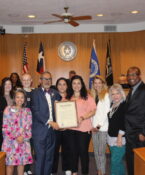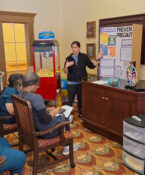No obvious change to Texas mobility trends after lifting of restrictions
By Alex Branch
The lifting of government lockdown restrictions does not to appear to have significantly impacted community mobility trends in Texas, a promising sign that a big surge in COVID-19 cases may not be imminent, according to a University of North Texas Health Science Center analysis.

People appear to continue to make pragmatic decisions about when and where to travel regardless of changes in government restrictions, said Dr. Rajesh Nandy, Associate Professor of Biostatistics and Epidemiology in the HSC School of Public Health. That trend is similar for much of the U.S. Evidence suggests community mobility is key to transmission.
“It is noteworthy that there is no discernible change in this trend irrespective of whether lockdown is in effect or lifted,” Dr. Nandy said. “It appears that people’s collective action is dictated by perceived threat rather than formal government proclamations.”
Tarrant County and Texas do not appear to have experienced a surge since the lifting of lockdown restrictions and the trend does not indicate a big surge in the short term, the report stated. Hospitals are operating well below surge capacity. However, Dr. Nandy cautioned that emergency preparedness and social-distancing guidelines remain vital to control the disease.
Dr. Nandy’s team analyzed data from the Johns Hopkins Coronavirus Resource Center, European Centre for Disease Prevention and Control, Google COVID-19 community mobility report, Tarrant County Public Health and the North Central Texas Trauma Regional Advisory Council.
The analysis studied U.S. mobility trends at the state level and classified the states into groups based on lockdown dates. Regardless of the date that lockdown orders took effect, the community mobility trend was almost identical across all four groups of states. The data showed a sharp decline in retail mobility — people visiting restaurants, shopping centers, museums, libraries, and movie theaters — in mid-March and a slow but steady increase since mid-April. There was no obvious change in that trend on or after lockdown restrictions were lifted in Texas.
“It almost appears that people across the nation collectively decided to lock down as soon as the threat from COVID-19 was imminent in the middle of March, irrespective of intervention from state and federal authorities,” Dr. Nandy said.
In the event of a second wave of COVID-19 transmission, mobility trends indicate people may self-correct their behavior and decrease mobility irrespective of issuance of a government mandate, Dr. Nandy found.
“This should give us hope in the event of a second surge in transmission,” he said.
HSC School of Public Health Dean Dennis Thombs said, “Dr. Nandy’s findings suggest that a large part of our population have adopted precautions to protect themselves and their families and have made these decisions independent of actions taken by our elected leaders.”
Tracking the pandemic
The University of North Texas Health Science Center at Fort Worth is monitoring the impact of COVID-19 on communities.
Rajesh R. Nandy, PhD, Associate Professor of Biostatics and Epidemiology at the HSC School of Public Health, authored the periodic reports.
Dr. Nandy will continue to track the impact of COVID-19 for the duration of the pandemic. Experts expect the pandemic will be an ongoing concern for the next 12 months or so. Here are the reports issued so far:
- COVID-19 Report – May 28, 2020
- COVID-19 Report – June 18, 2020
- COVID-19 Report – July 3, 2020
- COVID-19 Report – July 20, 2020



![Uyen Sa Nguyen Scaled[58]](https://www.unthsc.edu/newsroom/wp-content/uploads/sites/16/Uyen-Sa-Nguyen-scaled58-145x175.jpg)

Social media